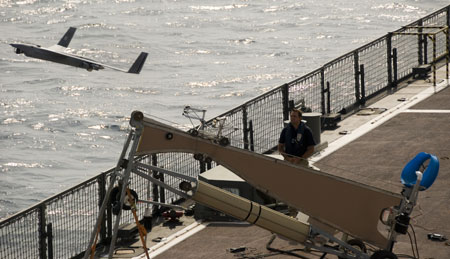SINGAPORE, March 02, 2009 -- ScanEagle, a long-endurance, fully autonomous unmanned aircraft system (UAS) developed by The Boeing Company [NYSE: BA] and subsidiary Insitu, today successfully completed a ship-based trial with the Republic of Singapore Navy (RSN).
The trial included both an RSN LST (Landing Ship, Tank) and a frigate. ScanEagle was launched and recovered from the ships' helicopter decks, flying day missions using an electro-optical camera payload and night missions using an infrared camera payload.
During the flights, the ScanEagle UAS successfully demonstrated sea-based launch and recovery capabilities and the ease with which the physical ground support equipment and control hardware can be integrated onboard. All tactical objectives and operational scenarios set for the flights were achieved.
"ScanEagle performed exceptionally well during the trials and proved it has the potential to be an asset for building the RSN's organic ship-based unmanned aerial vehicle capability," said Andrew Duggan, ScanEagle program manager for Boeing Defence Australia. "The ScanEagle UAS adds another dimension to persistent situational awareness for the ship's crew and generates actionable intelligence, surveillance and reconnaissance information."
Boeing Defence Australia provided a complete maritime ScanEagle system for the trial, including a ground control station, communication links, launcher and SkyHook recovery system. A Boeing Insitu team deployed to Singapore for the entire trial.
The ScanEagle UAS has operated from a variety of maritime platforms, most notably U.S. Navy ships since 2005, achieving 1,500 launches and recoveries. It has also operated from a UK Royal Navy Type 23 frigate and from commercial vessels.
Boeing Defence Australia began operating ScanEagle in December 2006. Since then, it has surpassed 16,000 flight hours supporting Australian Land Forces overseas as well as delivering in-country operator and field maintainer training.
 USA
USA

